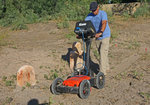Wind: mph,
Welcome to our new web site!
To give our readers a chance to experience all that our new website has to offer, we have made all content freely avaiable, through October 1, 2018.
During this time, print and digital subscribers will not need to log in to view our stories or e-editions.



There are only two grave markers in the old Picacho Cemetery located just outside Las Cruces near Shalem Colony and Fairacres and the names of fewer than 40 of the hundreds of children and adults buried there are known. But historical records and a lot of work by the Doña Ana County Historical Society (DACHS) have shown that several hundred people are buried in the cemetery, which was in use circa 1860- 1949.
Using cutting-edge technology, including ground-penetrating radar (GPR), CSTi (Construction Survey Technologies, Inc.) of Las Cruces has confirmed that about 400 unmarked graves are located on 1.2 acres on the north and south sites of the Village of Picacho Campo Santo de la Sagrada Familia Cemetery, including a couple of dozen graves that are stacked on top of each other.
“That’s a lot of unidentified people,” CSTi CEO and co-founder John Gallegos said at DACHS’s March 16 meeting at Good Samaritan Village.
GPR can’t identify the children and adults resting there – including many who likely died during the 1918-20 flu pandemic – but documenting the locations of their graves is important, Gallegos said. For the people buried there, it’s a way of saying “I matter again,” he said.
Gallegos, CSTi co-founder David Acosta and others from the company have made nearly a dozen visits to the cemetery since 2019 – volunteering their time and the use of their equipment – to locate the graves, which mostly lie about 3.5-eight feet below ground, Gallegos said.
“They’re exceptional,” DACHS member Sally Kading said about CSTi at the meeting. “They really have been wonderful.”
“We love to go out in the community,” Gallegos said, helping to “make the unknown known.”
In addition to confirming the location of graves, CSTi’s work also uncovered a couple of anomalies in the cemetery that have Gallegos and Acosta curious and may lead to some additional work.
“We know there’s something there,” he said.
“The next steps are to scan the acres that are not pedestrian accessible,” Gallegos said, and try to locate a child’s grave marker that has marbles and toy cars embedded in the top. Is there more to learn from GPR and similar technologies at the site? To be continued …”